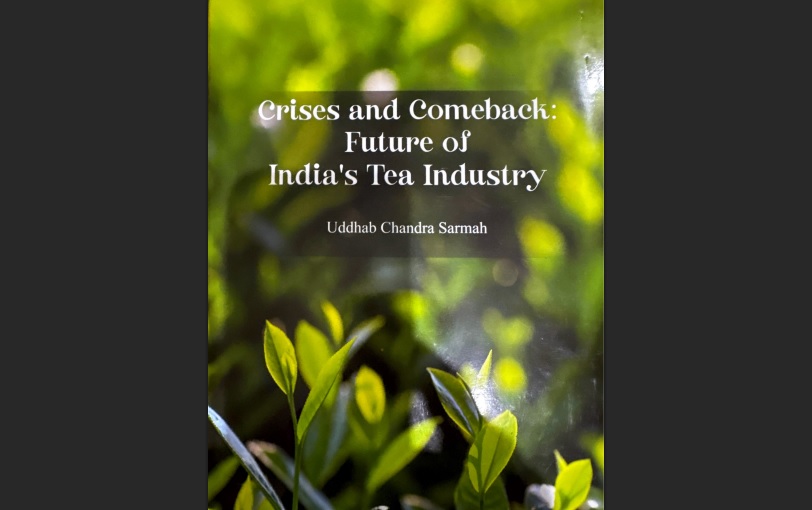The world of Indian tea, especially Assam tea, has always been more than just an industry. It is a way of life, a cultural identity, and a livelihood for millions.
Uddhab Chandra Sarmah’s remarkable book “Crises and Comeback: Future of India’s Tea Industry” is not only a memoir of his decades of experience as planter and executive but also an encyclopaedic account of the challenges, transitions, and opportunities that define this two-hundred-year-old legacy.
Through seventy-nine carefully crafted chapters, Sarmah offers a holistic vision that blends historical insight, contemporary analysis, and a roadmap for the future.
It is a book that both Central and State governments must take note of, for it addresses pressing socio-economic issues while charting strategies that could rejuvenate the sector.
The opening chapters ground the reader in the long historical arc of Assam’s tea, dating back to Robert Bruce’s discovery of the native Singpho tea plants in 1823, and the essential role of Adivasi workers who cleared forests and laboured tirelessly to establish the first plantations.
Sarmah is unflinching in acknowledging how these communities remain the backbone of production, even as their socio-economic conditions remain precarious.
The narrative traces migration, settlement, and resilience, weaving in the pride of Assam’s global tea reputation while reminding readers of the fragility of the workers’ lives. This duality—glory and crisis—is the heartbeat of the book.
The author then turns to the existential threats posed by climate change, showing with clarity how erratic weather, frequent droughts, and incessant rains have destabilized both productivity and the livelihoods dependent on it.
Here, Sarmah’s scientific outlook is evident: he prescribes practical, resilient farming techniques ranging from water management, crop rotation, and pest control through biological methods to the adoption of resistant cultivars and digital weather tools.
What emerges is a vision that goes beyond lamentation, presenting solutions rooted in both tradition and modernity. For policymakers, these are not just agronomic suggestions but calls to institutionalize resilience through coordinated research, extension services, and financial incentives.
The book also devotes considerable attention to the economic and structural problems of the sector.
High operational costs, stagnant auction prices, market contraction, and shrinking profitability plague large estates, while small tea growers—who now contribute over half of India’s total production—struggle with low prices, lack of bargaining power, and absence of direct market access.
Sarmah recognizes the paradigm shift toward smallholders, but he cautions that without robust policy frameworks, they remain vulnerable to exploitation and volatility.
His proposals include cooperatives, credit access, training in modern cultivation, quality certification, and direct linkages to markets.
He also advocates for minimum support price mechanisms and stabilization funds to shield growers from the brutality of market swings.
These are systemic recommendations, deserving urgent attention from both New Delhi and Dispur.
A distinctive strength of the book is its integration of social and cultural dimensions with economic discourse. Sarmah highlights the celebration of Bihu in tea planters’ clubs as an emblem of inclusivity, where workers, managers, and their families come together beyond social hierarchies.
Such narratives remind us that the tea industry is not merely about commodity production but about community resilience and cultural continuity.
Equally striking is the space he accords to women’s empowerment, recognizing that women form the majority of plantation workers and are central to both quality and sustainability.
Skill development, healthcare, safe working conditions, and leadership opportunities for women are presented not as welfare gestures but as imperatives for industry revival.
The environmental crisis occupies a central place in Sarmah’s analysis. He does not shy away from critiquing the indiscriminate use of chemical fertilizers and pesticides that have degraded soil, harmed biodiversity, and invited international scrutiny over pesticide residues.
His advocacy for integrated nutrient management, organic and regenerative practices, and strict compliance with maximum residue limits is not only about protecting the environment but also about safeguarding India’s place in global export markets.
In a world of rising consumer consciousness, Sarmah argues, quality and safety are as critical as volume. Governments would do well to heed these warnings, for trade barriers linked to food safety could severely undermine India’s export potential if left unaddressed.
Another notable aspect is Sarmah’s attention to innovation and entrepreneurship. He identifies opportunities in value addition—specialty teas, organic blends, tea-based products in food, beverages, cosmetics, and even bio-materials.
He sees tea tourism, wellness branding, and cultural heritage marketing as avenues for diversification, income generation, and global positioning.
For younger entrepreneurs, this is a call to reimagine tea not just as a plantation product but as a versatile lifestyle commodity. For governments, it is a reminder to create enabling ecosystems for start-ups, research, and export promotion.
Underlying the entire narrative is the theme of sustainability, approached in its fullest sense—ecological, economic, and social.
From climate-resilient practices to carbon credit systems that could provide new income streams for farmers, from HRD strategies to foster belonging and dignity among workers to international branding initiatives that can secure India’s position in global markets, Sarmah weaves a comprehensive tapestry.
The breadth of his vision is matched by the depth of his lived experience, as evident in the personal reflections, anecdotes, and even the humility he brings in acknowledging the role of colleagues, workers, and family in shaping his journey.
The book is also a reminder of the political economy of tea. Issues of taxation, unionization, government interference, and policy inconsistency surface throughout the chapters, often as barriers to progress. Sarmah argues for rationalization of taxes, interest subventions, crop insurance, and targeted subsidies.
But beyond financial relief, he insists on mindset changes—within management, among workers, and in policy circles—to view the industry not as a relic of colonial extraction but as a dynamic sector capable of leading India’s agricultural renaissance.
This shift in narrative is crucial, for only when governments see tea as both an economic and cultural asset will it receive the attention it deserves.
In the end, “Crises and Comeback” is more than a book. It is a manifesto for renewal.
It tells the story of how a planter who rose from assistant to executive director saw not only the inside of the industry but also its wider social ecosystem.
It documents the crises that threaten to erode two centuries of legacy but also points toward pathways of revival through sustainability, inclusivity, and innovation. Above all, it reminds us that tea is not just a beverage; it is employment, identity, heritage, and future.
If the government of India and the Government of Assam were to take Sarmah’s vision seriously—by institutionalizing resilience, empowering small growers, ensuring quality, and investing in innovation—the tea industry could not only overcome its crises but also script a remarkable comeback.
As the industry marks two hundred years of Assam tea, Sarmah’s voice is both warning and inspiration. It is a call to action for policymakers, planters, workers, and consumers alike. And as one of the industry’s most cherished sayings goes:
“Tea is the magic key to the vault where my brain is kept.” – Frances Hardinge.















